Sun Rising In The Morning
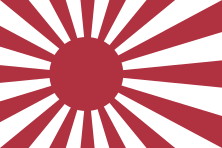
The Rising Sun Flag ( 旭日旗 , Kyokujitsu-ki ) is a Japanese flag that consists of a ruby-red disc and sixteen ruby-red rays emanating from the disc.[1] Similar the Japanese national flag, the Rising Dominicus Flag symbolizes the sun.
The flag was originally used by feudal warlords in Japan during the Edo menstruum (1603–1868 CE).[ii] On May 15, 1870, every bit a policy of the Meiji government, information technology was adopted as the war flag of the Imperial Japanese Regular army, and on October 7, 1889, it was adopted as the naval ensign of the Majestic Japanese Navy.[iii]
At present, the flag is flown by the Japan Maritime Self-Defence Force, and an eight-ray version is flown by the Japan Cocky-Defense Forces and the Japan Ground Self-Defense Force.[2] The ascension dominicus design is also seen in numerous scenes in daily life in Nippon, such as in fishermen's banners hoisted to signify large catches of fish, flags to celebrate childbirth, and in flags for seasonal festivities.[iv]
The flag is controversial in Korea and China, where information technology is associated with Japanese militarism and imperialism.[v] [6] [vii]
History and design


The keepsake ( mon ) of the Ryūzōji clan and Kusano clan, twelve lord's day-ray variation ( 変わり十二日足 )
The flag of Japan and the symbolism of the ascent Sunday has held symbolic meaning in Japan since the Asuka flow (538–710 CE). The Japanese archipelago is east of the Asian mainland, and is thus where the Sun "rises". In 607 CE, an official correspondence that began with "from the Emperor of the ascent sun" was sent to Chinese Emperor Yang of Sui.[8] Japan is often referred to as "the country of the ascension sun".[9] In the 12th century piece of work The Tale of the Heike, information technology was written that dissimilar samurai carried drawings of the Lord's day on their fans.[10]
The Japanese word for Japan is 日本 , which is pronounced 'Nippon' or 'Nippon' , and literally means "the origin of the sun". The character nichi ( 日 ) means "dominicus" or "day"; hon ( 本 ) means "base" or "origin".[xi] The compound therefore means "origin of the lord's day" and is the source of the popular Western epithet "State of the Rising Sun".[12] The red disc symbolizes the Sun and the red lines are calorie-free rays shining from the ascent sunday.
The design of the Ascension Sun Flag (Asahi) has been widely used since ancient times, and a part of it was called "Hiashi" ( 日足/ひあし ) and used every bit the samurai'due south crest ("Hiashimon" ( 日足紋 )).[13] [14] The flag was specially used by samurai in the Kyushu region. Examples include the "twelve dominicus-rays" ( 変わり十二日足 ) of the Ryūzōji association (1186–1607 CE) in Hizen Province and the Kusano association ( 草野氏 ) in Chikugo Province, and the "eight dominicus-rays" ( 八つ日足紋 ) of the Kikuchi clan (1070–1554 CE) in Higo Province. At that place is a theory that in many parts of the Kyushu region, Hizen and Higo are related to what was chosen "the land of Japan ( Hullo )".[15] [a]

There have been many types of Asahi flags since ancient times, and the design in which light rays spread in all directions without clouds expresses honored solar day or auspicious events, and was a pattern that was used for gloat a good catch, childbirth and seasonal festivities.[16] [17] [18] A well-known variant of the flag of the sun disc design is the sun disc with xvi crimson rays in a Siemens star germination. The Rising Sun Flag ( 旭日 旗 , Kyokujitsu-ki ) has been used as a traditional national symbol of Japan since at least the Edo period (1603 CE).[2] It is featured in artwork such as ukiyo-e prints, 1 example existence the Lucky Gods' visit to Enoshima ukiyo-e print past Utagawa Yoshiiku in 1869 and the I Hundred Views of Osaka, Three Great Bridges print by Utagawa Kunikazu in 1854. The Fujiyama Tea Co. used information technology as a wooden box characterization of Japanese green tea for export in the Meiji menstruation (1880s).[19]

The Ascension Lord's day Flag was historically used by the daimyō ( 大名 ) and Japan's military, specially the Imperial Japanese Army and the Imperial Japanese Navy. The ensign, known in Japanese equally the Jyūrokujō-Kyokujitsu-ki ( 十六条旭日旗 ), was first adopted as the war flag on May 15, 1870, and was used until the end of Earth War 2 in 1945. It was re-adopted on June 30, 1954, and is now used by the Japan Maritime Self-Defence force Force (JMSDF). The Japan Self-Defence Forces (JSDF) and Japan Ground Self-Defense Force (JGSDF) use a variation of the Ascent Sun Flag with red, white and golden colors.[20]
The pattern is similar to the flag of Japan, which has a red circle in the heart signifying the Sunday. The divergence compared to the flag of Japan is that the Rising Sun Flag has extra lord's day rays (16 for the ensign) exemplifying the name of Nippon every bit "The Land of the Ascent Sunday". The Regal Japanese Regular army commencement adopted the Rising Sun Flag in 1870.[21] The Imperial Japanese Regular army and the Royal Japanese Navy both had a version of the flag; the naval ensign was off-set, with the reddish sun closer to the lanyard side, while the army'due south version (which was office of the regimental colors) was centered. The flags were used until Nihon'south surrender in World War Two during August 1945. After the institution of the Japan Self-Defense Forces in 1954, the off-gear up Rising Sun Flag was re-adopted for the JMSDF and a new 8-rays Rise Sun Flag with a yellowish border for the JGSDF and JSDF was approved by the Supreme Commander for the Allied Powers (SCAP/GHQ). The flag with the off-set sun and 16 rays is the ensign of the Maritime Self-Defense Force, merely information technology was modified with a different colour red. The old flag is darker blood-red (RGB #b12d3d) and the post-WW2 modified version is brighter reddish (RGB #bd0029).[22]
The Majestic Japanese Army flag with symmetrical sixteen rays and a 2:three ratio was abolished. The Nippon Cocky-Defense Forces and the Ground Self-Defence Force employ a significantly dissimilar Rising Sun Flag with 8-rays and an 8:ix ratio. The edges of the rays are asymmetrical since they grade angles 19, 21, 26 and 24 degrees. It also has indentations for the xanthous (gold) irregular triangles forth borders. The JSDF Rising Sun Flag was adopted by a law/order/decree published in the Official Gazette of June xxx, 1954.[22]
Regardless of the military flag, before the Meiji period, the blueprint of Asahi was used for prayers, festivals, celebration events, reconstruction, logos of companies and products, large catch flags ( Tairyō-bata ), corporate and product logos and sports.[23] [24] [25] [26] [27] [28]
Present-mean solar day utilize
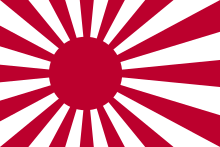

Commercially the Rising Sun Flag is used on many products, designs, wearable, posters, beer cans (Asahi Breweries), newspapers ( Asahi Shimbun ), bands, manga, comics, anime, movies, video games (such as E. Honda's stage of Street Fighter II, although this was removed in the 2021 re-release[29]), besides as appearing elsewhere. The Rise Lord's day Flag appears on commercial product labels, such as on the cans of i diverseness of Asahi Breweries lager beer.[30] Amongst fishermen, the tairyō-ki ( 大漁旗 , "Good Catch Flag") represents their hope for a good catch of fish. Today information technology is used as a decorative flag on vessels besides as for festivals and events. The Ascent Sun Flag is besides used at sporting events by the supporters of Japanese teams and individual athletes.[31]
Since June 30, 1954, the Rising Dominicus Flag has been the war flag and naval ensign of the Japan Maritime Cocky-Defense Strength (JMSDF). JSDF Principal of Staff Katsutoshi Kawano said the Rising Sun Flag is the Maritime Self-Defence force Forcefulness sailors' "pride".[32] The Nihon Cocky-Defense Forces (JSDF) and the Nippon Ground Self-Defence force Strength (JGSDF) use the Ascent Sun Flag with eight blood-red rays extending outward, called Hachijō-Kyokujitsuki ( 八条旭日旗 ). A gold border partially lines the edge.[20]
The flag is also used by non-Japanese, for instance, in the emblems of some U.South. military machine units based in Japan, and past the American blues rock band Hot Tuna, on the comprehend of its album Live in Japan. Information technology is used equally an keepsake of the United states Fleet Activities Sasebo, equally a patch of the Strike Fighter Squadron 94, a mural at Misawa Air Base, the former insignia of Strike Fighter Squadron 192 and Joint Helmet Mounted Cueing System with patches of the 14th Fighter Squadron. Some extreme correct-wing groups display it at political protests.[33]
Controversy
While Japan considers the ascension sun flag part of its history, many people in Korea, China, and other Asian countries say the flag is associated with Nippon's wartime atrocities, and is comparable to the Nazi swastika.[34] The Japanese imperial navy used the flag in the early 20th century every bit Japan colonized the Korean Peninsula, and invaded and occupied parts of Cathay and other Asian countries until its defeat in World State of war Ii in 1945.[34]
South Korean campaigns confronting the Rising Dominicus Flag began in earnest in 2011. In an association football match against Nippon, Due south Korean footballer Ki Sung-yueng was defendant of making a racist gesture, sparking outrage in Japan. Ki responded that he had intended to highlight the racism he had experienced at Celtic F.C. and that his "centre shed tears" after he saw the Rising Sun Flag at the match.[35] [36] On the other manus, many in Japan insist that the Ascent Sun Flag was not in the stadium.[35] [37] For this reason, there is a widespread view in Nihon that Ki Sung-yueng used the excuse of having seen the Rising Sun Flag to justify his racist gesture.[38] [39]
The flag is banned by FIFA, and Japan was sanctioned by the Asian Football Confederation (AFC) afterward Japanese fans flew information technology at an AFC Champions League game in 2017.[40]
In 2012, Due south Koreans who disapproved of the flag began to refer to it as a "war criminal offense flag".[41] [42] According to political scientist Kan Kimura, in 2012, post-obit Ki Sung-yueng'southward remarks, Koreans living in New York formed a political grouping "The Citizens Against State of war Criminal Symbolism" and started a campaign to equate the Ascension Sun Flag with the Nazi swastika and ban it. The following year at the 2013 EAFF Due east Asian Cup, a imprint with a slogan nearly historical issues with Nihon appeared on the Korean cheering squad. As these events were ofttimes reported in the Korean media, an international political movement among Koreans to equate the Ascent Lord's day Flag with that of the Nazi swastika and to prohibit it intensified.[43]
According to Koichi Nakano, professor of political scientific discipline at Sophia Academy, "no-ane in Nippon uses the ascent sun flag for any purpose other than romanticizing and rewriting the horrible human being rights abuses committed under the Japanese empire."[6] He suggests that the American Amalgamated flag, where it was used in the American civil war by southern states that wanted to keep slavery, would be a better comparison than the Flag of Nazi Deutschland.[six] The Confederate flag is non banned only is a symbol of racial segregation and perceived superiority, according to critics.[6]
Southward Korea did not object to Japan'due south adoption of the Rising Sun Flag for the Nihon Maritime Cocky-Defense in 1952, nor to the entry into S Korean ports Japanese warships flying the flag on a warship at the 1998 and 2008 navy armada reviews held in South korea.[44] However, when hosting an international armada review at Jeju Island from October 10 to 14, 2018, South Korea requested all participating countries to display only their national flags and the South Korean flag on their vessels, a request plain aimed at preventing Nihon from flying the Rising Dominicus Flag, which had been the ensign of the Japanese Maritime Self-Defense Force since information technology was established in 1954. Nihon announced on Oct 5, 2018 that it would exist withdrawing from the fleet review because it could not accept Seoul's request to remove the Ascent Sun Flag. Japanese officials say the flag is mandatory for Nippon's naval ships nether domestic laws and is widely recognized every bit identification for the Japanese armed services under an international maritime convention. On October half-dozen, 2018, JSDF Main of Staff Katsutoshi Kawano said the Rising Sun Flag was the "pride" of Maritime Self-Defense Force sailors, and that the JMSDF would admittedly not go if they had to remove the flag.[1]
The South Korean parliamentary committee for sports asked the organizers of the 2020 Summer Olympics in Tokyo to ban the Ascension Sun Flag, with Due south Korean lawmaker An Min-suk stating that the Olympics could not proceed peacefully with the flag in the stadium. In September 2019, the Chinese Civil Clan for Claiming Compensation from Japan sent a letter of the alphabet to the International Olympic Commission (IOC) to ban the flag.[45] According to the Associated Press, the IOC confirmed the receipt of the alphabetic character and said in a statement "sports stadiums should be free of any political demonstration. When concerns arise at games time nosotros await at them on a case by case footing."[46] In 2021, South korea'south Olympic committee said that in substitution for taking downwardly banners at the Olympic village that referred to the Imjin War, which was ruled past the IOC as provocative, the IOC promised that the rising sun flag will be banned at stadiums and other Olympic venues.[47] At the cease of the Tokyo 2020 Olympics, a delegate from South korea said that there were no diplomatic incidents betwixt Republic of korea and Japan during the Olympics, adding that "information technology was an 'achievement of sports diplomacy' for South korea that IOC had decided to ban Nippon's Rising Sun flag."[48] In response, the Tokyo Organising Committee of the Olympic Games announced on ix August, "The announcement by the South Korean Olympic Committee is non truthful. When nosotros contacted the IOC, nosotros confirmed that the IOC will go along to answer to the issue on a case-by-case footing and will non impose a blanket ban. On the morning of 9 August, the IOC had sent a letter to Republic of korea indicating that the utilise of the flag will be determined on a example-past-case ground."[49] [l]
Alexis Dudden, a professor of history at the University of Connecticut, argued that the rising sun flag should be banned at the 2020 Summer Olympics because the flag "is part of a collective effort to cleanse the history of imperial Japan's assailment during the second world state of war," therefore causing intentional harm to those who suffered under Japanese dominion.[51] She added that it was unsurprising that the South Korean authorities was the starting time to raise objections to the flag being waved at the 2020 Olympics, since Korea was occupied past Japan from 1910 until 1945.[51]
In 2021, Capcom removed the appearances of the Rising Dominicus Flag from their re-release of Street Fighter II. Capcom did not provide an official reason for the flag's removal, but it is guessed that the flag was removed in an endeavour not to offend any parts of the international gaming community.[29] [52] [53]
The Japanese authorities's basic position on the Rising Sun Flag is that "claims that the flag is an expression of political assertions or a symbol of militarism are absolutely faux."[54] The Sankei Shimbun , a right-fly Japanese paper, criticized Due south Korea's attitude toward the Ascension Sun Flag, stating that fifty-fifty the United states, who had opposed Nippon during World War II, had not protested formally against the Rise Sun Flag.[55] [56] The same newspaper argued that the history of the flag dates back much further than Globe War II,[57] and that the corporate logo of the Asahi Shimbun , which is praised for being careful in Due south Korea,[58] likewise uses the rise sun design.[59]
The Japanese Vexillological Association states that the flag was designed for the Japanese army in the early Meiji period, with a different version adopted by naval forces,[57] stating that "Flags used by the military machine are domestic decisions",[57] arguing that "the Ascension Dominicus flag existed before Japan went to war and the nature of the result is different from that of the swastika flag, which was created to symbolize the Nazi authorities's political ideologies."[57] Former Prime number Minister Shigeru Yoshida has stated that "There is no country in the earth that does not know this flag. The flag can be recognized equally Japan's in any sea", with the flag having been adopted for its "recognizability" equally the naval flag of the JMSDF.[57]
Examples of the Rising Dominicus Flag blueprint in use
Art
-

I Hundred Views of Osaka, 3 Great Bridges, ukiyo-e print by Utagawa Kunikazu, 1854. The composition shows the morning sun rising backside the Nanhwa Iii Bridge.
-

From "Good and evil child'south hand", "Kiyomori entrance" (Adachi Ginbo, 1885)
-

"Fukujin Sakana Irifune" (author unknown, 19th century Edo period)
-

The postcard of anti-Tuberculosis groups in Nihon (June 27, 1925)
-

Suehiro Tokyo sights - the Edobashi office of Communications and Transportation (1882)
Products
-
Tairyō-bata is a traditional Japanese fisherman's flag. Today it is used as a decorative flag on vessels and for festivals and events.
-

Postcard of a Japanese woman draped in the ascension sun flag of Japan (1910).
-

-

Asahi Beer poster. The Asahi logo is on the canteen label, 1920s
-
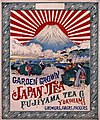
Wooden box label (Fujiyama Tea Co.) of Japanese green tea for export in the Meiji/Taisho period. Such a label was called orchid.
-

"Yamagata telephone launch ceremony" postcard (Yamagata mail office, 1907). Phone exchange service began in Yamagata on Nov 26, 1868.
-
Nihon raw silk pack sticker (in French and Japanese) (1880)
Sports
-
Japanese footballing fans moving ridge a Rising Sun Flag during a Japan vs. Republic of bosnia and herzegovina match in January 2008.
-

-

Sumo wrestler Asashio Tarō I with ascension sun waves kesho mawashi , 1901
Japan Cocky-Defense Forces
-

-

-

Self-Defence force Forces flag of the JGSDF 46th Infantry Regiment
Usa military
Other
Run across also
- Royal Seal of Japan
- List of Japanese flags
- List of Japanese municipal flags
Notes
- ^ In modern times, it is likewise used as a simple design, for instance, Yurikamome Inc. (visitor), Hinode Station blueprint.
References
- ^ a b "Nippon to skip South Korea armada event over 'ascension sun' flag". AP NEWS. October 5, 2018. Retrieved April 13, 2021.
- ^ a b c "Japanese Symbols". Japan Visitor/Japan Tourist Info. Retrieved October ix, 2014.
- ^ "船舶旗について" (PDF). Kobe University Repository:Kernel. Retrieved October xviii, 2014.
- ^ "The Rising Sun Flag As Part Of Japanese Culture" (PDF). Ministry building of Strange Affairs of Japan. November 8, 2019. Retrieved September 10, 2020.
- ^ "Southward Korea compares Japan'due south 'rising sun' flag to swastika as Olympic row deepens". the Guardian. October 29, 2019. Retrieved January 20, 2021.
- ^ a b c d "Tokyo 2020: Why some people want the rising lord's day flag banned". BBC News. January iii, 2020. Retrieved January nine, 2022.
- ^ Kim, Hyung-Jin; Yamaguchi, Mari (July 23, 2021). "Why Japan'south 'rise sun' flag is provoking anger amongst some at the Olympics". Los Angeles Times . Retrieved Jan ix, 2022.
- ^ Dyer 1909, p. 24 harvnb error: no target: CITEREFDyer1909 (help)
- ^ Edgington 2003, pp. 123–124 harvnb error: no target: CITEREFEdgington2003 (help)
- ^ Itoh 2003, p. 205 harvnb fault: no target: CITEREFItoh2003 (aid)
- ^ "Where does the proper name Japan come up from?". Retrieved January 29, 2017.
- ^ Piggott, Joan R. (1997). The emergence of Japanese kingship. Stanford Academy Press. pp. 143–144. ISBN978-0-8047-2832-four.
- ^ "日足紋". www.harimaya.com.
- ^ "家紋の由来". www.harimaya.com.
- ^ "見聞諸家紋". www2.harimaya.com.
- ^ 韓国世論「旭日旗とナチス党旗を同一視」の大いなる誤解 サーチナ 2013年4月16日
- ^ 中国においても、広東語で通勝と称される中国古来の黄暦には、古くから春牛図が描かれており、その図中の日の意匠は日本の旭日に類似していた(豊作祈願)芒神春牛圖
- ^ Rising Sun Flag Ministry building of Strange Affairs of Nippon
- ^ Designer Idezaka (September nine, 2013). 浮世絵と西洋の出合い 戦前の輸出茶ラベルの魅力 [Ukiyo-e and Western run into The charm of the exported tea characterization earlier the state of war]. Nikkei Style (in Japanese). Archived from the original on October iv, 2018. Retrieved October 4, 2018.
- ^ a b "自衛隊法施行令" [Self-Defense Forces Law Enforcement Guild] (in Japanese). Government of Nippon. June 3, 1954. Archived from the original on April seven, 2008. Retrieved January 25, 2008.
- ^ "海軍旗の由来". kwn.ne.jp. Retrieved Oct half-dozen, 2011.
- ^ a b Phil Nelson; various. "Japanese armed services flags". Flags of the World. Flagspot.
- ^ "神戸新聞NEXT|淡路|新造船、鮮やか大漁旗まとい進水式 淡路市". www.kobe-np.co.jp (in Japanese). Retrieved October 12, 2018.
- ^ "天然マダイ船12年ぶり進水 糸島の船越漁港". 西日本新聞Web (in Japanese). Retrieved Oct 12, 2018.
- ^ "【オリックス】新守護神・増井、「大漁旗」モチーフ応援グッズ発売". スポーツ報知 (in Japanese). Apr iii, 2018. Retrieved October 12, 2018.
- ^ "オリックス増井応援グッズは故郷焼津市の大漁旗原案 – プロ野球 : 日刊スポーツ". nikkansports.com (in Japanese). Retrieved October 12, 2018.
- ^ "宗像大社みあれ祭:大漁旗はためかせパレード – 毎日新聞". 毎日新聞 (in Japanese). Retrieved October 12, 2018.
- ^ "<塩釜みなと祭>震災と豪雨復興願う 御座船、松島湾巡る「頑張ろう西日本!」掲げた船も". 河北新報オンラインニュース (in Japanese). Retrieved October 12, 2018.
- ^ a b "Rise Lord's day removed from 'Street Fighter II' background in game's latest rerelease". JAPAN TODAY. February 22, 2021. Retrieved July 5, 2021.
- ^ "Asahi Beer New Design". Japan Visitor Blog. December 12, 2011.
- ^ "A corking decade for Japan". FIFATV. December ane, 2012. Archived from the original on January 1, 2013.
- ^ "Nippon to skip Due south. Korea fleet upshot over 'ascent sun' flag". The Asahi Shimbun. October 6, 2018. Archived from the original on October six, 2018. Retrieved October vii, 2018.
- ^ "World: Asia-Pacific Reprise for Japan'southward canticle". BBC News. August fifteen, 1999.
- ^ a b "EXPLAINER: Why Nihon 'ascent sunday' flag provokes Olympic ire". ABC News.
- ^ a b "South Korean footballer'southward monkey impression angers Japan". The Guardian. January 28, 2011. Archived from the original on November 12, 2020.
- ^ "「旭日旗」問題の契機はサッカー・アジア杯 奥薗静岡県立大准教授" [Rising Sunday Flag controversy began at an Asian Cup Football lucifer – Associate Professor of the University of Shizuoka Okuzono]. Sankei Shimbun. October 5, 2018. Archived from the original on October 6, 2018.
- ^ "Why did a Korean soccer player insult the Japanese past mimicking a monkey?". MSN News. February 2, 2011. Archived from the original on March 5, 2016.
- ^ "Why is Asahi Shimbun OK? South Korea'south campaign to oust the Rise Sun Flag has been inconsistent". J-CAST News. August half-dozen, 2013. Archived from the original on February 15, 2021.
- ^ "The power hidden in S Korea's campaign confronting the Ascent Sun Flag. The target is likewise Republic of korea'southward leading companies, entertainers and toys". Yahoo News Nihon. March four, 2021. Archived from the original on March 4, 2021.
- ^ "Tokyo Olympic organizers say no plans to ban 'Ascent Sun' flag despite South Korean demand". Reuters.com. September thirteen, 2019. Retrieved May 24, 2022.
- ^ "[Why] 욱일기 때문에 불참통보한 일본군함, 우린 왜 지금 더 분노하나" [[Why] The Japanese warship conveyed an absence. Why are nosotros angry now?]. The Chosun Ilbo. October half dozen, 2018. Archived from the original on October 6, 2018.
- ^ "[팩트체크] 욱일기는 전범기? '전범기'는 없다" [[Fact bank check] Rising Sun Flag is state of war crime flag? At that place is no "state of war criminal offense flag"]. News True or Fake. Oct half-dozen, 2018.
In the moving-picture show above, the discussion "state of war crime flag" was start used in Korea in Baronial 2012.
- ^ Kan Kimura. "New Aspects of Korean Nationalism Seen in the Rising Sunday Flag Problem" (PDF). Journal of International Cooperation Studies, Vol.27, No.1. pp. 31–37. Archived from the original (PDF) on November 12, 2020. Retrieved January 29, 2021.
- ^ "[특파원 칼럼] 대일외교, '감정'보다 '사실' 앞세워야" [Foreign diplomacy, Put forward "fact" rather than "emotion"]. Korea Economic Daily. October 12, 2018.
- ^ "China group asks IOC to ban 'rising lord's day' flag at 2020 Olympics". September 2, 2019. Archived from the original on October ane, 2019.
- ^ "S. Korea urges IOC to ban Japanese imperial flag from 2020 Olympics". Kyodo News. September 12, 2019. Retrieved September v, 2020.
- ^ "South Korea removes controversial banners from Tokyo Olympic village - National". Globalnews.ca . Retrieved May 24, 2022.
- ^ Park, Ju-min (August 8, 2021). "S.Korea misses gold medal target only praises no clash with Nippon". Reuters.com . Retrieved May 24, 2022.
- ^ "The issue of the Ascent Lord's day Flag at the Olympics. The Tokyo Organizing Committee for the Olympic Games appear, "There is no fact that the IOC has banned it."". Yahoo News Nippon. August 9, 2021. Archived from the original on Baronial nine, 2021. Retrieved Baronial ix, 2021.
- ^ "The IOC informed South Korea that the banning of the Rising Sun Flag is not truthful". Yahoo News Japan. August 9, 2021. Archived from the original on August 9, 2021. Retrieved Baronial ix, 2021.
- ^ a b "Nihon'southward rise sunday flag has a history of horror. It must be banned at the Tokyo Olympics | Alexis Dudden". TheGuardian.com. November 2019.
- ^ "Controversial Rising Sun Blueprint Removed From Street Fighter II's Re-Release". nintendolife.com. February 19, 2021. Retrieved May 24, 2022.
- ^ "Rising Sun Removed From Street Fighter II In Capcom Arcade Stadium". Kotaku.com.au. Feb nineteen, 2021. Retrieved May 24, 2022.
- ^ "Rise Sun Flag: Nippon's basic position (Press Conference by the Chief Cabinet Secretary SUGA, September 26, 2013(AM))". MOFA, Japan. November 8, 2019. Retrieved September 5, 2020.
- ^ 韓国の反日から旭日旗の名誉を守れ (第三段 国際社会は受け入れ) Archived Baronial 9, 2013, at the Wayback Machine 産経新聞 2013年8月3日
- ^ "日本の艦艇、旭日旗を掲げて韓国に入港し物議=韓国ネット「...|". レコードチャイナ. Retrieved July 17, 2018.
- ^ a b c d east "Why the Uproar Over Japan'southward Ascension Sun Flag? It's A Symbol for Celebrating Life and Bounty". Sankei Shimbun, Japan Forward. Dec 19, 2018. Archived from the original on Jan 17, 2021.
- ^ "日우파기자가 밝힌 우파들의 본심" [Real intention of the rightist revealed by a Japanese rightist reporter]. The Chosun Ilbo.
- ^ 皆川豪志. "なぜ韓国人は、朝日の社旗に怒らないのか,繰り返されるマッチポンプ". iRONNA. 産経デジタル. Retrieved May 18, 2018.
External links
-
 Media related to Ascent Sun Flag of Nippon at Wikimedia Eatables
Media related to Ascent Sun Flag of Nippon at Wikimedia Eatables - "Rising Sunday Flag", MOFA, Japan, 27 July 2021.
- MOFA, Japan (6 September 2021), "Ascent Sun Flag equally Japanese Longstanding Culture", YouTube.
Sun Rising In The Morning,
Source: https://en.wikipedia.org/wiki/Rising_Sun_Flag
Posted by: davisplefusbacce.blogspot.com




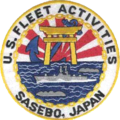


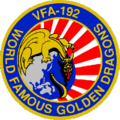


0 Response to "Sun Rising In The Morning"
Post a Comment